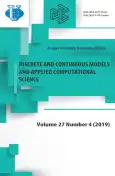Эффективная вычислительная схема для описания динамики иона в радиочастотном поле ловушки Пауля
- Авторы: Мележик В.С.1,2
-
Учреждения:
- Объединённый институт ядерных исследований
- Государственный университет «Дубна»
- Выпуск: Том 27, № 4 (2019)
- Страницы: 378-385
- Раздел: Математические модели в физике
- URL: https://journal-vniispk.ru/2658-4670/article/view/328269
- DOI: https://doi.org/10.22363/2658-4670-2019-27-4-378-385
- ID: 328269
Цитировать
Полный текст
Аннотация
В статье разработана эффективная вычислительная схема для интегрирования классических уравнений Гамильтона, описывающих динамику ионов пленённых радиочастотным полем ловушки Пауля. Она позволила провести количественные расчёты резонансных атомно-ионных столкновений в гибридных атомно-ионных ловушках с учётом неустранимого микродвижения ионов, вызванного радиочастотными полями (V.S. Melezhik et. al., Phys. Rev. A100, 063406 (2019)). Важным элементом гибридных атомно-ионных систем является электромагнитная ловушка Пауля, удерживающая заряженный ион. Колебательное движение пленённого иона определяется двумя частотами ловушки Пауля. Это частота порядка 100 кГц из-за постоянного электрического поля и радиочастоты 1-2 МГц определяется переменным электромагнитным полем ионной ловушки. Необходимость точного описания движения ионов в комбинированном поле с двумя временными шкалами, задаваемыми двумя сильно различающимися частотами, потребовала разработки устойчивой вычислительной схемы для интегрирования классических уравнений (Гамильтона) движения ионов. Кроме того, требуется устойчивость схемы на достаточно большом интервале времени столкновения иона с холодным атомом ∼ 10 × 2/, определяемом частотой атомной ловуш- ки ∼ 10 кГц, и в сам момент столкновения атома с ионом при сильной связи уравнений Гамильтона. Разработанный численный метод учитывает все отмеченные особенности задачи и позволяет с необходимой точностью интегрировать систему связанных квантово-квазиклассических уравнений и количественно описывать процессы атомно-ионных столкновений в гибридных ловушках, включая резонансные эффекты.
Об авторах
В. С. Мележик
Объединённый институт ядерных исследований; Государственный университет «Дубна»
Автор, ответственный за переписку.
Email: melezhik@theor.jinr.ru
Doctor of Physical and Mathematical Sciences, Leading Researcher of Bogoliubov Laboratory of Theoretical Physics, Joint Institute for Nuclear Research; professor of Dubna State University
ул. Жолио Кюри, д. 6, г. Дубна, Московская область, 141980, Россия; ул. Университетская, д. 19, г. Дубна, Московская область, 141980, РоссияСписок литературы
- M. Tomza, K. Jachymski, R. Gerritsma, A. Negretti, T. Calarco, Z. Idziaszek, and P. S. Julienne, “Cold hybrid ion-atom systems,” Reviews of Modern Physics, vol. 91, no. 3, p. 035 001, 2019. DOI: 10. 1103 / RevModPhys.91.035001.
- V. S. Melezhik, Z. Idziaszek, and A. Negretti, “Impact of ion motion on atom-ion confinement-induced resonances in hybrid traps,” Physical Review A, vol. 100, no. 6, p. 063 406, 2019. doi: 10.1103/PhysRevA. 100.063406.
- V. S. Melezhik and P. Schmelcher, “Quantum energy flow in atomic ions moving in magnetic fields,” Physical Review Letters, vol. 84, no. 9, pp. 1870-1873, 2000. doi: 10.1103/physrevlett.84.1870.
- V. S. Melezhik, “Recent progress in treatment of sticking and stripping with time-dependent approach,” Hyperfine Interactions, vol. 138, no. 1, pp. 351-354, 2001. doi: 10.1023/A:1020833119205.
- V. S. Melezhik, J. S. Cohen, and C.-Y. Hu, “Stripping and excitation in collisions between and He+( ⩽ 3) calculated by a quantum timedependent approach with semiclassical trajectories,” Physical Review A, vol. 69, no. 3, p. 032 709, 2004. doi: 10.1103/PhysRevA.69.032709.
- V. S. Melezhik and L. A. Sevastianov, “Quantum-semiclassical calculation of transition probabilities in antiproton collisions with helium ions,” in Analytical and Computational Methods in Probability Theory, V. V. Rykov, N. D. Singpurwalla, and A. M. Zubkov, Eds., Cham: Springer International Publishing, 2017, pp. 449-460.
- J. Joger, H. Frst, N. Ewald, T. Feldker, M. Tomza, and R. Gerritsma, “Observation of collisions between cold Li atoms and Yb+ ions,” Physical Review A, vol. 96, no. 3, 030703(R), 2017. doi: 10.1103/physreva.96. 030703.
- H. Fürst, T. Feldker, N. V. Ewald, J. Joger, M. Tomza, and R. Gerritsma, “Dynamics of a single ion-spin impurity in a spin-polarized atomic bath,” Physical Review A, vol. 98, no. 1, p. 012 713, 2018. DOI: 10. 1103 / physreva.98.012713.
- T. Feldker, H. Fürst, H. Hirzler, N. V. Ewald, M. Mazzanti, D. Wiater, Tomza, and R. Gerritsma, “Buffer gas cooling of a trapped ion to the quantum regime,” 2019. arXiv: 1907.10926 [quant-ph].
- D. Leibfried, R. Blatt, C. Monroe, and D. Wineland, “Quantum dynamics of single trapped ions,” Reviews of Modern Physics, vol. 75, pp. 281- 324, 2003. doi: 10.1103/RevModPhys.75.281.
- D. J. Berkeland, J. D. Miller, J. C. Bergquist, W. M. Itano, and D. J. Wineland, “Minimization of ion micromotion in a Paul trap,” Journal of Applied Physics, vol. 83, no. 10, pp. 5025-5033, 1998. DOI: 10.1063/1. 367318.
- L. D. Landau and E. M. Lifshitz, Mechanics. New York: Pergamon, 1976, pp. 93-95, 93-95.
- E. Hairer, C. Lubich, and G. Wanner, Geometric numerical integration. Structure-preserving algorithms for ordinary differential equations. Berlin, Heidelberg: Springer, 2006, ch. I.
Дополнительные файлы









